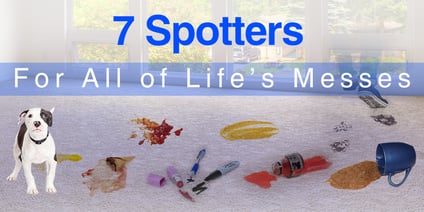The crayon technique for spot color repair to carpets is a convenient and portable means of restoring the color to small spots sometimes encountered when cleaning carpets and upholstery. The techniques suggested here are available for both professional and home use.
The term “small spots”, means spots that typically result from dripping chlorine bleach on a deep blue plush, a small animal urinating on a light beige high-low, or residual shoe polish on a white shag. *Note: the crayon technique is not intended for large-scale color repairs.*
The crayon or Crayola spot dye system works well on nylon fiber as well as on fibers that cannot normally be spot dyed in the field such as olefin and polyester.
The color change is semi-durable but can be removed over time due to traffic or can be cleaned away with hot water extraction.
The Tools Required for Spot Color Repair on Carpet
- A large box of crayons. I like the Crayola Classic Colors box of 96 as it contains shades close to the colors of those used in many carpets.
- A spray bottle of rubbing alcohol or possibly a chlorinated solvent if available. Chlorinated solvents work well for this purpose but introduce health, safety, and environmental concerns. They are restricted in many areas.
- A functional household-type steam iron or a wallpaper steamer such as the AC210.
- Several pieces of heavy brown Kraft paper
- A bone scraper
- A supply of white wiping towels
- A ceramic or glass surface can make a good palette for mixing. Do not use anything which has sharp edges that can cut you.
How to Work with Color on Carpet
The technician operator should have a reasonable understanding of basic color composition. The primary colors are yellow, red, and blue. These can be combined to make secondary colors of green, orange, and purple. All 3 mixed in various amounts will produce shades of gray or brown.
With Crayola, the colorist is working with a wax that contains pigments or dyes. Some colors have a combination of pigments and dyes. Others will be only pigments or only dyes. White and black will be only pigment and wax. The white crayon is likely to contain titanium dioxide as the pigment. Carbon black is likely to be the pigment in the black crayon. The wax used in Crayola has a very low melting point.
The basic idea is to wet out the spot with alcohol or another solvent and to keep the spot wet as long as necessary to make the desired color match. The solvent solubilizes the color-containing wax. When dissolved, the color can be spread as desired.
Of course, test the particular solvent to be used before commencing. Will the solvent damage the backing adhesive, carpet, yarn, or adjacent color? In any event, apply spray only to the amount of solvent sufficient to keep the working area damp. Do not apply an excess because it will only drain down into the backing adhesive. A light spray frequently is better than a heavy occasional spray.
How Do I Color-Repair Spots on the Carpet?
There are two options for repairing the color on spots that have been removed.
#1 Color can be mixed on the palette. Keep a mixing area of the palette damp with rubbing alcohol. Rub the crayons in this area. Combine colors until the right shade has been obtained. Apply this to the carpet fiber with a white towel dampened with alcohol or another solvent.
#2 The technician can simply spray on the solvent and start coloring with the crayons.
Start with a shade lighter than that ultimately desired. Work up to the darker shade gradually. Combine colors as necessary to yield the desired shade.
REMEMBER: It is easier to add color than to remove color!
It is just like mixing paint. For instance: Starting with a yellow or gold spot in an otherwise green pile, the operator should start with a light blue crayon and not a green crayon, Blue and yellow make green. (If you don’t believe me, ask the Tidy Bowl man.)
Need a deeper tone? Spray more solvent to keep the nap damp. Apply a different color in the range desired.
Need a lighter shade? Try the white or a pastel crayon.
If the tech gets the wrong color, is too dark a color, or for other reasons wants to change the color that is on the carpet fiber, it can be wiped off with a white cotton towel as long as this is done before the color is set with the iron.
When the color dries, if the spot is too shiny cover the spot with Kraft paper and rub it with the steam iron. For this purpose, the steam iron should be used dry and set at the lowest temperature setting. If the spot is not excessively shiny, cover the area with a single layer of white towel and apply steam heat from an iron at the lowest setting that will produce steam or with the Wagner wallpaper steamer. Be careful not to melt the carpet with whatever heat source you use!
About 30 seconds of steam heat should set the color so that it will not be easily removed.
Should the color be washed away from the surface by some subsequent event, try the following: Use a Wagner wallpaper steamer. Apply the steam from iron about 2” above the spot. Use the steam lightly. As the steam evaporates, the softened color should migrate back to the tips of the fibers.
The 96-color box of Crayola costs very little on Amazon.com. Use the crayons straight, or blend one, two, or three colors at will. Color spots for revenue, to make a friend, or to show the customer how. Small spots should not be permitted to detract from the overall beauty of any carpeted floor or piece of upholstered furniture.
A box of Crayola Crayons should be standard equipment for every professional carpet and upholstery cleaner.
This post is based upon information printed in Production Manual published by The Society of Cleaning Technicians (now Society of Cleaning & Restoration Technicians) in October 1974
Prepared from material presented by Mr. Murray Cremer. Cremer’s Rug & Upholstery Cleaner, Long Beach, CA., Joint ASDS, Int. / Calf. CARPET CLEANERS Technical Seminar, Santa Monica, CA., September 1974
by Scott Warrington
Enjoyed reading this post? Read the following articles:




